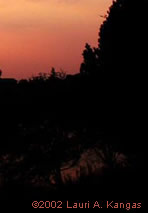| Sunset rays - Ontario, Canada |
 Image Index |
|
||||||||||||
Sunset
rays Ontario, Canada by Lauri
Kangas (site)
9th September 2002. ©2002 Lauri A Kangas.
The rays appear to radiate upwards because of perspective
effects. In reality they are
slanting gently downwards to reach the ground behind the camera .
Lauri's colour essay tells us much about light and the atmosphere. The
sunset colours
result from light scattered by very small dust and aerosol particles
and the air itself. The scattering is greatest when the sun is low and
its rays traverse long distances through the air. Shorter wavelength
blue light is scattered more strongly than red leaving the sun's residual
transmitted rays rich in reds and orange.
The rays show this reddening by their warm pinkish hues contrasting
with the background blue scattered light from the sky. The rays themselves
are made visible by scattering, but that they retain the sun's reddened
hues indicates that their light was scattered by relatively large water
droplets or aerosols in the lower atmospheric levels. These particles
are Mie scatterers;
unlike very small particles they do not preferentially scatter blues
and other shorter wavelengths.
The cloud undersides are dark because the near horizontal sunlight does
not penetrate them. Some of their rims have traces of "silver
linings".
The dimmer water reflections appear to have deeper colours. When searching
the sky near the sun for halos,
iridescent clouds
and coronae
it is useful to view it by reflection in water.
Look carefully at the sun and nearby trees and their reflections. Reflected
scenes are not "mirror images"! They differ from the
real view because the effective eye positions for setting the perspective
of reflected images is beneath the water ~ but that's another story!



